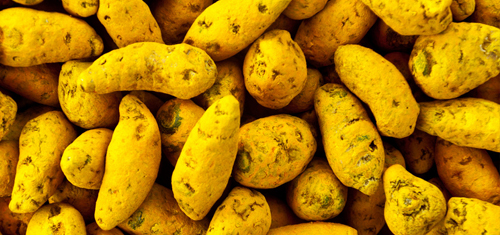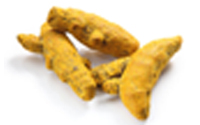Turmeric
Turmeric
Pronounced: tur-mer-ik

Turmeric (Curcuma longa) has been used for 4,000 years to treat a variety of conditions. Studies show that turmeric may help fight infections and some cancers, reduce inflammation, and treat digestive problems. Turmeric is widely used in cooking and gives Indian curry its flavor and yellow color. It is also used in mustard and to color butter and cheese. Turmeric has been used in both Ayurvedic and Chinese medicine as an anti-inflammatory, to treat digestive and liver problems, skin diseases, and wounds.
What Is Turmeric?
 A member of the ginger family, turmeric is a perennial plant that is cultivated throughout tropical Asia, India, and China. The plant grows to a height of 0.9 to 1.5 m and bears large, oblong leaves and funnel-shaped, dull yellow flowers. It has a thick rhizome, which is yellowish on the outside and deep orange or reddish brown inside. The lateral rhizomes contain more yellow coloring than the bulb. The dried primary bulb and secondary lateral rhizomes are collected, cleaned, boiled, and dried for use in medicinal and food preparations.
A member of the ginger family, turmeric is a perennial plant that is cultivated throughout tropical Asia, India, and China. The plant grows to a height of 0.9 to 1.5 m and bears large, oblong leaves and funnel-shaped, dull yellow flowers. It has a thick rhizome, which is yellowish on the outside and deep orange or reddish brown inside. The lateral rhizomes contain more yellow coloring than the bulb. The dried primary bulb and secondary lateral rhizomes are collected, cleaned, boiled, and dried for use in medicinal and food preparations.
Plant and Cultivation
Turmeric is a plant that is cultivated and propagated with the help of its rootstalk. It thrives the best on loamy or alluvial, loose, friable and fertile soils. It grows at all places ranging from sea level to an altitude of 1220 m above MSL. It is very sensitive to low atmospheric temperature. It is grown both under rain fed and irrigated conditions. Like other tuber crops, turmeric also requires deep tilth and heavy manuring for high yields. Beds of convenient length and width are prepared based on the topography of the land. Planting is done either on raised beds or on ridges. The turmeric plant needs temperatures between 20°C and 30°C and a considerable amount of annual rainfall to thrive. The yield of this crop also depends on the amount of rainfall it gets, as it requires an appropriate amount of water to survive. Also, the water shouldn’t be alkaline in nature as it is harmful for growth of the plant. Individual plants grow to a height of 1 m, and have long, oblong leaves. The harvesting of this plant is done when the leaves of this plant start turning yellowish after 7 to 10 months of plantation. The plant is harvested by digging the rootstalks up. It is grown from the sea level to 1200 meters above mean sea level.
Plants are gathered annually for their rhizomes, and are reseeded from some of those rhizomes in the following season. The rhizome, from which the turmeric is derived, is tuberous, with a rough and segmented skin. The rhizomes mature beneath the foliage in the ground. They are yellowish brown with a dull orange interior. The main rhizome is pointed or tapered at the distal end and measures 2.5–7.0 cm (1–3 inches) in length and 2.5 cm (1 inch) in diameter, with smaller tubers branching off. When the turmeric rhizome is dried, it can be ground to a yellow powder with a bitter, slightly acrid, yet sweet, taste.
Description
Turmeric is a product of Curcuma longa, a rhizomatous herbaceous perennial plant belonging to the ginger family Zingiberaceae, which is native to tropical South Asia. Turmeric is a perennial plant that grows 5 to 6 feet high in the tropical regions of Southern Asia, with trumpet-shaped, dull yellow flowers. Its roots are bulbs that also produce rhizomes, which then produce stems and roots for new plants. Turmeric is fragrant and has a bitter, somewhat sharp taste. Although it grows in many tropical locations, the majority of turmeric is grown in India, where it is used as a main ingredient in curry. Before turmeric can be used, the turmeric rhizomes must be processed. Rhizomes are boiled or steamed to remove the raw odor, gelatinize the starch, and produce a more uniformly colored product.
More than 100 components have been isolated from turmeric. The main component of the root is a volatile oil, containing turmerone, and there are other coloring agents called curcuminoids in turmeric. Curcuminoids are found to be natural antioxidants.
Producing Countries of Turmeric
Turmeric cultivation is confined to South East Asian countries such as India, Sri Lanka, China, Indonesia, Australia, Africa, Peru and the West Indies.
Consuming Countries of Turmeric
The major importers of turmeric are the Middle East and North African countries, Iran, Japan and Sri Lanka. These importing countries represent 75% of the turmeric world trade, and are mostly supplied by the Asian producing countries.
Grades of Turmeric
Dried Turmeric Finger
Alleppey Finger From Kerala
Rajapuri Finger From Maharashtra
Salem Gattha Finger From Tamil Nadu
Nizamabad Finger From Andhra Pradesh
| SPECIFICATION | SUGGESTED LIMITS |
|---|---|
| ASTA CLEANLINESS SPECIFICATION | |
| Whole Dead Insects, by Count | 3 |
| Mammalian excreta, by mg / lb | 5 |
| Other excreta, by mg / lb | 5 |
| Mold.% by Weight | 3 % |
| Insect Defiled / Infested, % by Weight | 2.5 % |
| Extraneous,% by Weight | 0.5 % |
| FDA DAL'S | |
| Curcumin Content | 5.0 % Min |
| Moisture" | 10.0 % Max |
| Ash" | 8.0 % Max |
| Acid Insoluble ash" | 1.0 % Max |
